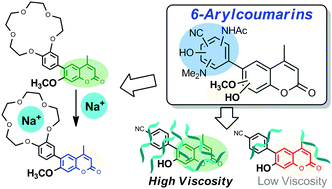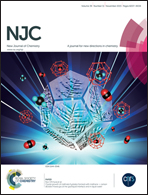6-Arylcoumarins: versatile scaffolds for fluorescent sensors†
Abstract
Fluorescent sensors are used in many fields of scientific research. Here, we proposed that 6-arylcoumarins could be scaffolds for various types of fluorescent sensor. From our newly synthesized 6-arylcoumarins, 6-(p-cyanophenyl)-7-hydroxycoumarin was found as a ratiometric viscosity sensor, that is, it exhibits two fluorescent peaks in low-viscosity solution, but only one in high-viscosity solution. In addition, 6-arylcoumarins bearing a 7-methoxy or 7-hydroxyl group exhibit large shifts of fluorescence maximum wavelength that are dependent upon the 6-aryl substituents. So we considered that these compounds would be good candidates as scaffolds for fluorescent sensors that would utilize the shift of fluorescence maximum wavelength for analyte detection. To validate this idea, we designed, synthesized and characterized two sodium ion sensors, in which a 15-crown-5 ether moiety is attached to the 6-phenyl group of these scaffolds as the recognition site; these sensors exhibit a blue shift of the fluorescence maximum wavelength in the presence of sodium ion. Our results suggest that 6-arylcoumarins are available as versatile scaffolds for various types of fluorescent sensors.


 Please wait while we load your content...
Please wait while we load your content...